 Knox County Conservation District
Knox County Conservation DistrictPhone: 865-523-3338 x 3
Fax: 855-584-5853 4730 New Harvest Lane, Suite 200
Knoxville, Tennessee 37918
E-mail: Cynthia.Foster@tn.nacdnet.net
Knox County Soil Conservation District administers cost-share assistance to Knox County landowners. Cost-share funds come from Federal and State funding pools that encourage landowners to implement Agricultural Best Management Practices (Ag. BMPs) on their property. Best Management Practices are conservation-minded efforts designed to reduce soil erosion and improve water quality. Because Agriculture is exempt from regulations designed to address non-point source water quality issues in fields like Construction, we ask for voluntary support from farmers and landowners with the added incentive of helping them pay for the cost and installation of these practices. In this way, the landowner benefits from these practices that ultimately save them time and money in resource management, and the community benefits from the reduction in soil loss on Agricultural lands and the resulting improvement in water quality.
Below are examples of Ag. BMPs commonly used in Knox County:
Alternative Watering Systems
This is by far our most commonly implemented Ag. BMP in Knox County. As you can see from the photo on the left, a watering trough located in a central location on a farm is extensively used by livestock to the point where no grass can grow around the trough. This is referred to as a “Heavy Use Area”. The photo on the right shows a Ritchie Watering System that is designed to resist mosquito breeding and freezing while supplying ready and available water to livestock at any time during the year. This water tank is surrounded by a companion practice called Heavy Use Area Protection. The Heavy Use Area Protection is basically a 6” layer of crusher run stone set atop geotextile matting. The tank itself sits on a thick slab of concrete in the middle of the Heavy Use Area. This practice effectively reduces soil erosion and benefits farmers on a host of levels involving water supply and water quality for livestock.
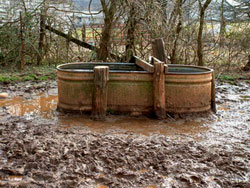
BEFORE
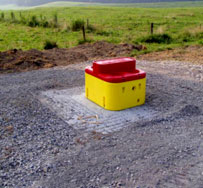
AFTER
Stream Crossings
Stream Crossings are extensively used by landowners running cattle operations on farms located near local streams and rivers. Often, this is the only water source for livestock on certain areas of farms where they are confined to. As you can see from the photo on the left, this constant traffic by half-ton animals can cause severe soil erosion along stream banks. We encourage landowners to install stream crossings, which are stabilized areas constructed across a stream using concrete or crusher run rock. Both sides of the stream crossing are fenced off so that cattle can only enter the stream in one central location. This significantly reduces the amount of sediment that enters the streams adjacent to farmlands.

BEFORE
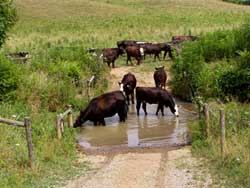
AFTER
Using Native Warm-Season Grasses for Wildlife Habitat
Native grasslands are the most endangered ecosystem in the Mid-South. Historically, the region contained vast acreages of native grassland and savannas with scattered trees and shrub cover, which was maintained by fire. Today, that acreage has been replaced with non-native grasses (e.g., tall fescue, orchardgrass and bermudagrass), agricultural crops, forest cover and suburban development. As a result, several wildlife species dependent upon quality early successional habitat have experienced significant declines in population. Native warm season grasses (NWSG) can be used to enhance early successional cover for species such as bobwhite quail, cottontail rabbit, field sparrow, Henslow’s sparrow, grasshopper sparrow, indigo bunting, prairie warbler, dickcissel, eastern meadowlark, loggerhead shrike, American kestrel, northern harrier and others. Fields of NWSG and associated forbs (broadleaf herbaceous plants) are also used by wild turkeys for nesting and brood rearing and by white-tailed deer for bedding and escape cover.
NWSG are established for wildlife primarily because of the structure of cover provided
. Suitable cover is more often a limiting factor for species such as quail, rabbits and grassland songbirds than food. NWSG are not planted as food plots.

Mixture of Big Blue Stem, Little Blue Stem and Indian Grass - makes excellent habitat for Quail
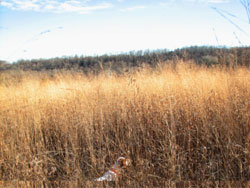
Switchgrass
Exclusion Fencing
We assist landowners in obtaining cost-share funds to install fencing of all kinds. One of the most commonly used kinds of fencing is Exclusion Fencing. Exclusion Fencing keeps livestock out of local waterways to reduce soil erosion on stream banks and decrease levels of fecal Coliform and e.Coli in streams. Agriculture is the primary contributor of fecal Coliform bacterium in local streams and rivers. By excluding livestock from water sources that are contaminated and providing these animals with clean water fed through alternative watering systems, exclusion fencing also contributes to better overall livestock health and weight.
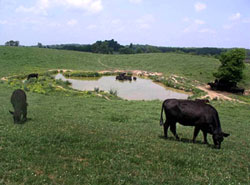
Before
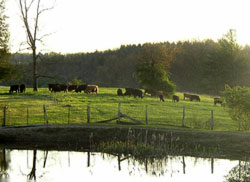
After
Streambank Stabilization
Streambanks on Agricultural land are at risk of severe erosion when farmers use local waterways as a water source for their livestock, as mentioned in the previous practice (Exclusion fencing). Since sediment is the largest pollutant of our nation’s waterways, streambank erosion is considered an urgent conservation need. We provide technical and financial assistance to farmers who are able to address streambank erosion on their land using stabilization techniques that can include rip-rap and jetties, gabion baskets, cedar tree revetments, grading practices, riparian buffers and willow stake vegetation. We use a host of different management techniques to address each project’s unique topographic and functional nature.
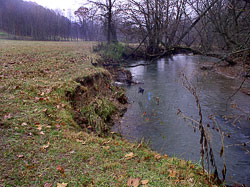
Before
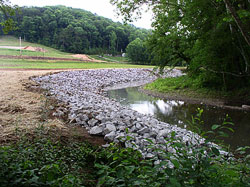
After
No-Till / Conservation Tillage
No-till is a method of planting seed with minimal disturbance to the soil. The harvested crop’s stalk and roots remain in the ground and a special no-till drill is used to plant seed in the remaining stalk of the old crop. This method also utilizes land management and crop selection to minimize necessary herbicide application.
Conservation tillage is a method of cultivating crops to reduce soil erosion. Soil loss through water erosion is greatly reduced when crop residue is left on the soil surface and soil drainage, organic matter, and moisture content are improved. Conservation tillage also reduces air pollution (dust and diesel emissions), sequesters carbon (inhibiting global warming), improves water quality, and creates wildlife habitat. Conservation tillage uses half as many tractors to cultivate a field as conventional tillage, translating to lower fuel consumption and labor costs, decreased material inputs, and less maintenance spending. In total, savings have been estimated between $40 and $75 per acre per year, a large savings compared to input cost and crop value. (Sustainable Conservation,
www.suscon.org
)
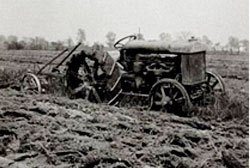
Conventional Tillage
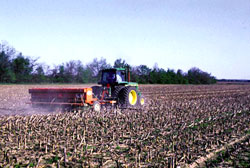
No-Till Planting
Historical aerial photos (from 1939, 1953, 1973 and 1992)
The Knox County SCD has transferred our historical aerial photos (from 1939, 1953, 1973 and 1992) to the East Tennessee History Center at 601 S. Gay Street in downtown Knoxville. The photographs and their keys are available for use during their hours of operation:
9:00 am - 8:30 pm Monday - Tuesday
9:00 am - 5:30 pm Wednesday - Friday
9:00 am - 5:00 pm Saturday
1:00 pm - 5:00 pm Sunday
Evenings and weekends parking is free in all three public garages. Weekdays they can validate your parking ticket for two hours of free parking if, and only if, you park in the Locust Street Garage (located on Locust Street between Union Ave. and Clinch Ave.) Please bring the ticket with you to the library.


